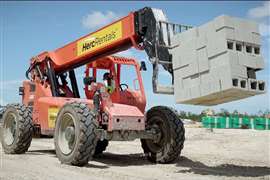Economic outlook Middle East: Unrest impact
10 May 2011

While the so-called "Arab Spring" may be a prelude to a more open political environment, the ensuing economic uncertainty will create a more volatile construction market and one that is somewhat cloudier to judge.
The good news for the Middle East is that the most disruptive revolutions have occurred just to the west of the region in Tunisia, Egypt and most violently, Libya. Nevertheless, Yemen, Syria, Iran and Bahrain have all seen some demonstrations, the latter resulting in a Saudi military presence. While it is unlikely that a major energy producing state will be toppled, investment hates uncertainty. The interesting question is whether the high energy prices brought on by the crises will be enough to cushion, or even transcend any weakness in business confidence.
Recovery
The pace of recovery around the region was already varied, although all construction markets apart from Iran will see an improvement in 2011, compared to 2010.
Superficially, it looks like Iran actually turned in one of the better performances of 2010, but it would be more accurate to say it is recovering previously lost ground. The toll of sanctions, especially in the energy sector, and aging infrastructure suggests that Iran will not be able to capitalise on the rebound in oil prices to the same extent as other oil producers in 2011 or 2012.
Qatar, meanwhile, offers the world's highest GDP per capita and also the best construction growth in the near term. Infrastructure spending to get the country's vast natural gas reserves to market is a clear driver, but the non-residential segment is also performing well. Some of this is due to development for the 2022 football World Cup, but there is also strong office development around the expanding financial centre and the building of a world class medical complex.
Saudi Arabia is also well positioned for growth in the near and medium term. It has the ability to expand oil production as prices rise. While not the region's construction growth leader, very strong growth in 2011 and 2012 come on top of a 2010 that did outperform most of the region.
Improvements to and further expansion of upstream energy installations is a major component of the country's growth. However, Saudi Arabia has one of the world's youngest populations and is aggressively pursuing strategies to increase employment.
Residential spending
The development of industrial cities continues the national strategy of diversifying the economy and creating new jobs outside of the oil sector. The government has also announced substantial funding for housing to address the shortage and high cost of existing residential space, which has been a source of tension among the nation's youth. The result is a stronger residential outlook than in past forecasts in both the short and medium term.
Indeed, residential spending has been a centerpiece of government packages aimed at quelling popular unrest in several countries, with Algeria and Jordan announcing major spending plans last month. Kuwait, like Saudi Arabia, has a rapidly rising young generation and while there have not been any large protests, significant residential spending has been proposed.
Bahrain and Jordan have been the construction markets in the Middle East most affected by unrest. The likely outcome is one that maintains stability, and IHS Global Insight expects continued growth. However, the projected pace of expansion has been lowered, due to weakness in the non-residential sector, where private finance is vital.
The UAE will continue to repair the damage from its real estate market. As a result, construction growth is coming from the rejuvenation of postponed projects rather than new initiatives. Fortunately there is no sign of the return to the excesses of the last decade, but the model for economic diversification remains and is being resurrected.
Uncertainty
Israel is also affected by the region's uncertainty. Nations on her borders are experiencing some of the most profound change (Egypt) and reported violence (Syria). There is also renewed activity on the part of terrorists in the Palestinian territories, although that has so far remained contained.
While no one doubts Israel's ability to maintain its security, uncertainty over Egypt's position in particular has been a public source of concern. Recovery for this large, but slow growing construction market remains expected, but the outlook has been scaled back somewhat, particularly within the commercial building sector.
The most likely outcome is that Middle Eastern construction markets will weather the unrest and resume the path of strong growth. However, some countries will see problems in the short term until investors regain confidence.
Countries with strong balance sheets and energy assets will be able to offset investor angst with government intervention, particularly in the long neglected housing sector. Infrastructure investments tied to energy could even be accelerated should high oil prices be sustained. However, it is more important than ever to look on a country-by-country basis than at a regional level for growth opportunities.






